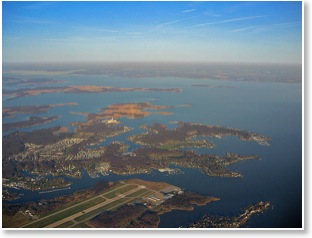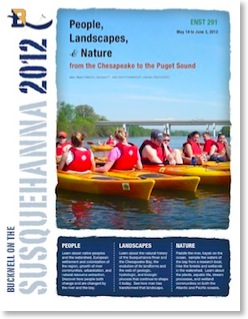ENST 291
People, Landscapes, and Nature ...
from the Chesapeake to the Puget Sound Watersheds
May 14 through June 3, 2012
People, Landscapes, and Nature ...
from the Chesapeake to the Puget Sound Watersheds
May 14 through June 3, 2012
The Susquehanna River is the greatest contributor of fresh water to the Chesapeake Bay, the largest estuary in the United States. The Puget Sound is the second largest estuary, an arm of the Pacific Ocean that extends inland where it meets 19 different river basins. The Bay and the Sound experience tidal flows and there is a changing mixture of fresh and salt waters.
 These watersheds have been the home of Native Americans for thousands of years, who relied upon the rivers and forests for their livelihood. But from the earliest European settlements to the 21st century, these regions have undergone vast changes in land use, including logging, oil and natural gas development, coal mining, agriculture, industrialization and urban growth.
These watersheds have been the home of Native Americans for thousands of years, who relied upon the rivers and forests for their livelihood. But from the earliest European settlements to the 21st century, these regions have undergone vast changes in land use, including logging, oil and natural gas development, coal mining, agriculture, industrialization and urban growth.
Since the 1970s, the overall health of the rivers and coastal areas have been gradually improving in distinct ways, especially as abandoned mine discharge and sediment and pollutant runoff is addressed and reduced. Of great importance is the continued monitoring of the estuaries and regulation of water withdrawals from the basin and the quality of discharges to the estuaries. Another benefit has been the implementation of best management practices (BMPs) by the agriculture, timbering, mining, and natural gas industries.
The difficulties these watersheds face are complex and the Susquehanna River and Puget Sound face enormous pressure from many different directions. Additional research and awareness is needed, especially of its hydrology and physical habitat, and how dissolved oxygen fluctuations, heavy metals and endocrine disrupters are affecting aquatic life. Also of concern is the potential impact of the development of natural gas reserves in the Marcellus Shale, which underlies much of the watershed’s headwater regions.
The mission of Bucknell on the Susquehanna is exactly that, to provide you a life-changing, field-based experience that is:

Since the 1970s, the overall health of the rivers and coastal areas have been gradually improving in distinct ways, especially as abandoned mine discharge and sediment and pollutant runoff is addressed and reduced. Of great importance is the continued monitoring of the estuaries and regulation of water withdrawals from the basin and the quality of discharges to the estuaries. Another benefit has been the implementation of best management practices (BMPs) by the agriculture, timbering, mining, and natural gas industries.
The difficulties these watersheds face are complex and the Susquehanna River and Puget Sound face enormous pressure from many different directions. Additional research and awareness is needed, especially of its hydrology and physical habitat, and how dissolved oxygen fluctuations, heavy metals and endocrine disrupters are affecting aquatic life. Also of concern is the potential impact of the development of natural gas reserves in the Marcellus Shale, which underlies much of the watershed’s headwater regions.
The mission of Bucknell on the Susquehanna is exactly that, to provide you a life-changing, field-based experience that is:
- on-the-river, in the forests, wetlands, and farm fields
- throughout-the-watersheds, from the headwaters to the coasts
- across-the-country from the Atlantic to the Pacific oceans

